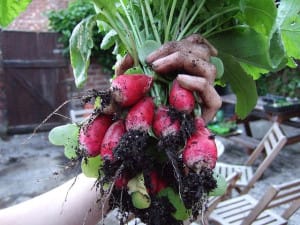Let your plants do double duty in protecting your soil in the fall and getting your garden ready for spring.
Rodale News
by Julia Westbrook
 |
What you do in the garden this fall can have a big impact on your growing season next spring. One of the best vegetables you can plant this fall is the forage radish, according to research from the University of Maryland.
With funding from Sustainable Agriculture Research & Education (SARE), the researchers found that in no-till, no fertilizer, and no herbicide farms, plots that grew forage radishes in the fall had a better yield of spinach in the spring versus plots that used an oat cover crop or had no cover crop.
Like most cover crops, this radish’s quick growth and broad leaves means that it suppresses weeds. But this plant serves double duty and will till the soil for you, too. Cornell University College of Agriculture and Life Sciences explains that the strong root drills into and loosens the soil. When it dies over the winter, the open channel left behind allows the soil to dry and warm up faster in the spring.
Plus, most cover crops have to be tilled back into the soil in the spring, but since these radishes die over the winter (and do the tilling for you), there’s no need for you to break your back doing it.
Letting the plants till your garden is also much kinder to the ground than if you try to do it yourself. “Too many tiller turns around the garden pulverizes the soil and destroys its structure, says Deborah L. Martin, author of Rodale’s Basic Organic Gardening. “Tilling also reduces the organic matter content of your soil by speeding up decomposition of the soil’s organic reserves. Tilling is also hard on earthworms—the whirling tines chop up some worms and leave others exposed to drying sun and wind.”

